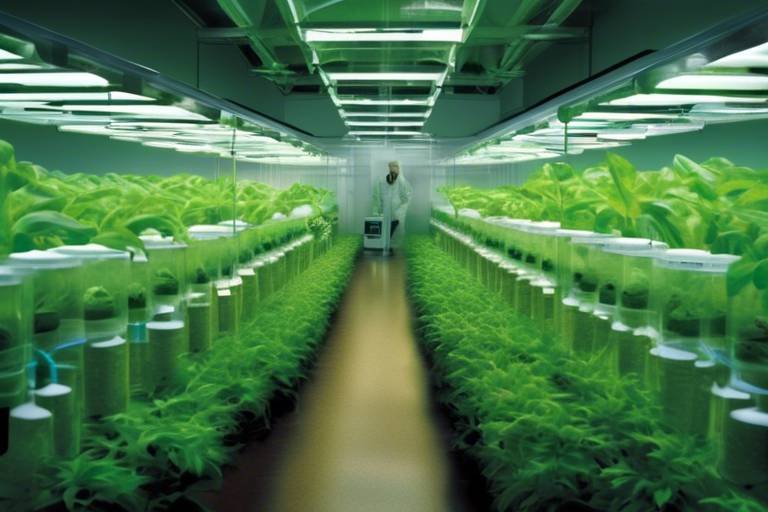Future Trends in Space Technology - Commercial Space Travel
As we stand on the brink of a new era in exploration, the concept of commercial space travel is no longer confined to the pages of science fiction. With the rapid advancements in space technology, private companies are not just dreaming about the stars; they are building the pathways to get there. This article dives deep into the exciting developments shaping the future of space tourism, exploring the innovations driving this industry, the challenges that lie ahead, and the potential impact on our understanding of the universe.
Space tourism is experiencing a remarkable surge in interest and investment. Thanks to pioneering companies like SpaceX, Blue Origin, and Virgin Galactic, the dream of orbiting Earth is becoming a reality for more than just astronauts. These companies are not only competing for market share but are also pushing the boundaries of what is possible in human spaceflight. Imagine a future where a weekend getaway includes a trip to the edge of space, offering breathtaking views of our planet from above. The possibilities are as vast as the universe itself!
The backbone of commercial space travel lies in the innovations in spacecraft design. Engineers and designers are focusing on creating vessels that prioritize both safety and comfort for passengers. From the materials used to the layout of the cabins, every detail is being meticulously crafted to ensure an experience that is as thrilling as it is secure. Advanced technology, such as artificial intelligence and sophisticated navigation systems, is being integrated into spacecraft to enhance operational efficiency and passenger experience.
One of the most groundbreaking advancements in space technology is the development of reusable rockets. This innovation is revolutionizing the economics of space travel. By allowing rockets to be launched multiple times, companies can significantly reduce the costs associated with each mission. This not only makes space travel more affordable but also increases the frequency of launches. Imagine a world where space tourism is as common as taking a flight across the country!
Understanding the financial implications of reusable rockets is essential for grasping how they are changing the landscape of space travel. The cost of sending a payload or a group of tourists into space has historically been astronomical (pun intended!). However, with reusability, the cost per launch can drop dramatically. For example, a typical launch cost can be reduced from tens of millions of dollars to just a fraction of that. This shift is paving the way for a broader audience to experience the wonders of space.
As we venture into the cosmos, we must also consider our ecological responsibilities. The environmental impact of space travel is becoming a hot topic of discussion. Companies are actively looking for ways to minimize their ecological footprints, adopting sustainable practices such as using biofuels and developing cleaner propulsion systems. The goal is to explore the universe while ensuring we do not leave a trail of pollution behind. After all, we want to preserve the beauty of our planet and beyond for future generations.
The establishment of dedicated spaceports is critical for the growth of commercial space travel. These facilities are not just launch pads; they are hubs of innovation and collaboration. Current developments in spaceport infrastructure include state-of-the-art launch facilities, passenger terminals, and ground support systems. The implications for the industry are profound, as these spaceports will serve as the gateways to our journey into the stars.
As the commercial space travel industry expands, it encounters a complex web of regulatory challenges. Navigating legal and safety regulations across different jurisdictions can be a daunting task for companies. The lack of a unified regulatory framework means that companies must adapt to varying rules and standards, which can slow down progress and innovation.
Collaboration between countries is essential for developing effective regulations. By working together, nations can create a cohesive regulatory environment that fosters innovation while ensuring safety. International partnerships can help streamline the regulatory process, making it easier for companies to launch their missions and for tourists to experience space travel.
Establishing robust safety standards is critical for public confidence in space tourism. The current safety protocols are designed to ensure that every aspect of a spaceflight is meticulously planned and executed. Companies are investing heavily in research and development to enhance safety measures, from rigorous testing of spacecraft to comprehensive training for crew members. The goal is to make space travel as safe as possible, allowing passengers to focus on the awe-inspiring experience rather than worrying about their safety.
Commercial space travel is not just about tourism; it is paving the way for future exploration. The advancements in this sector may contribute to deeper space missions and scientific discoveries that could change our understanding of the universe. As private companies continue to innovate, we may soon see missions to the Moon, Mars, and beyond, opening up new frontiers for humanity.
- What is commercial space travel? Commercial space travel refers to the private sector's efforts to provide transportation to space for tourists and other non-professional astronauts.
- Who are the key players in the space tourism industry? Major companies include SpaceX, Blue Origin, and Virgin Galactic, among others.
- How does reusable rocket technology benefit space travel? Reusable rockets significantly reduce costs and increase the frequency of space missions, making space travel more accessible.
- What are the environmental impacts of space travel? The industry is working on sustainable practices to minimize ecological footprints, such as using biofuels and cleaner propulsion systems.

The Rise of Space Tourism
Space tourism is no longer a concept confined to the realms of science fiction; it is rapidly transforming into a thrilling reality. With private companies leading the charge, the idea of taking a vacation among the stars is becoming increasingly feasible. Imagine looking down at Earth from a vantage point that only a handful of people have ever experienced! Companies like SpaceX, Blue Origin, and Virgin Galactic are at the forefront of this revolution, each boasting ambitious plans to make space travel accessible to the everyday person.
In recent years, we've witnessed a surge in investments and technological advancements aimed at making space tourism a viable industry. The allure of space travel is not just about the experience; it’s about creating a whole new market that could potentially be worth billions. According to industry experts, the space tourism market could reach a staggering $1 trillion by 2040, opening up opportunities not just for thrill-seekers but also for scientific research and education.
So, who are the key players in this burgeoning industry? Let’s take a closer look:
- SpaceX: Known for its ambitious missions to Mars, SpaceX is also working on commercial flights for private citizens. Their Crew Dragon spacecraft is designed to take passengers to the International Space Station (ISS) and beyond.
- Blue Origin: Founded by Jeff Bezos, Blue Origin's New Shepard rocket offers suborbital flights, allowing passengers to experience a few minutes of weightlessness and breathtaking views of Earth.
- Virgin Galactic: This company focuses on suborbital spaceflights and has already conducted successful test flights with its SpaceShipTwo vehicle, bringing us one step closer to commercial operations.
As these companies continue to innovate, they are not just competing for market share; they are also vying to capture the imagination of the public. The idea of spending a few days in space, enjoying luxurious accommodations while gazing at the cosmos, is incredibly enticing. In fact, some companies are even planning to build space hotels! Yes, you heard that right—hotels in space where guests can enjoy a unique experience far beyond anything available on Earth.
However, with great ambition comes great responsibility. The rise of space tourism also raises questions about safety, environmental impact, and accessibility. How do we ensure that this new frontier remains safe for travelers? What measures are being taken to minimize the ecological footprint of space travel? These are crucial considerations that the industry must address as it moves forward.
In conclusion, the rise of space tourism is not just a fleeting trend; it represents a significant shift in how we view our place in the universe. With private companies pushing boundaries and turning dreams into reality, the prospect of traveling to space is becoming an exciting possibility for many. As we stand on the brink of this new era, one can’t help but wonder: Are we ready to embrace the cosmos?

Innovations in Spacecraft Design
When we think about space travel, the first image that often comes to mind is a sleek, shiny spacecraft soaring through the cosmos. However, the design and engineering behind these vessels are evolving at an astonishing pace, and it's this evolution that is making commercial space travel not just a dream, but a reality. Innovations in spacecraft design are crucial for enhancing safety, comfort, and overall travel experience for passengers. From cutting-edge materials to advanced propulsion systems, the future of space travel is here, and it's more exciting than ever!
One of the most significant advancements in spacecraft design is the integration of smart technology. Just like our smartphones have transformed everyday life, smart technology is revolutionizing how we approach space travel. Imagine a spacecraft equipped with artificial intelligence that can analyze data in real-time, predict potential issues, and even adjust its systems autonomously. This kind of technology not only enhances safety but also ensures a smoother journey for passengers. Additionally, the use of lightweight materials is becoming increasingly popular. These materials reduce the overall weight of the spacecraft, allowing for more efficient fuel consumption and increased payload capacity. The combination of smart technology and lightweight construction is paving the way for more ambitious missions.
One of the most groundbreaking innovations in spacecraft design is the development of reusable rocket technology. Companies like SpaceX have made headlines with their Falcon 9 rocket, which can return to Earth and be refurbished for future flights. This reusability is a game-changer in the commercial space travel industry. Not only does it significantly lower costs, but it also increases the frequency of missions, making space travel more accessible to the average person. Imagine being able to hop on a rocket for a weekend getaway to the stars, all thanks to the ingenuity of reusable technology!
Understanding the financial implications of reusable rockets is essential. The traditional model of space travel, where rockets are used once and discarded, is not sustainable. By reusing rockets, companies can drastically cut down on launch costs. For example, the cost of launching a Falcon 9 rocket can be reduced from tens of millions of dollars to just a fraction of that when the rocket is reused. This shift in financial strategy is making space travel not just a luxury for the wealthy but a viable option for many. It's like buying a car that you can drive for years instead of renting one every time you need to go somewhere!
As we push the boundaries of space travel, we must also consider the environmental impact of our innovations. The space industry is becoming increasingly aware of its ecological footprint, and many companies are adopting sustainable practices. For instance, some are exploring the use of biofuels and other green technologies to power their spacecraft. This not only helps in reducing emissions but also ensures that our quest for exploration does not come at the cost of our planet. It's a delicate balance, much like trying to enjoy a campfire without letting it get out of control!
The establishment of dedicated spaceports is vital for the growth of commercial space travel. Just as airports serve as hubs for air travel, spaceports will become the launch pads for our journeys into the cosmos. Current developments in spaceport infrastructure include advanced launch systems, improved ground support equipment, and enhanced passenger facilities. These innovations are not just about getting people into space; they're about creating a seamless travel experience from the moment you arrive at the spaceport to when you touch down back on Earth. Imagine walking through a spaceport that feels like a futuristic terminal, complete with lounges and entertainment options while you wait for your flight to the stars!

Reusable Rockets
The development of reusable rocket technology is nothing short of a game-changer in the realm of space travel. Imagine this: instead of discarding a rocket after a single use, we can now retrieve and refurbish it for future missions. This revolutionary approach not only slashes costs but also opens up a world of possibilities for commercial space travel. The concept of reusability is akin to using a rechargeable battery instead of constantly buying new ones; it’s sustainable, economical, and efficient.
Companies like SpaceX and Blue Origin have spearheaded the movement towards reusable rockets, demonstrating that this technology is not just a pipe dream but a tangible reality. For instance, SpaceX's Falcon 9 rocket has successfully completed multiple missions with the same first stage, showcasing the potential for cost-effective space travel.
One of the most significant benefits of reusable rockets is the reduction in launch costs. Traditional rockets, which are typically discarded after each flight, can cost millions of dollars per launch. In contrast, reusing a rocket can lower these costs dramatically. To illustrate, let’s take a look at a comparison of costs:
| Rocket Type | Cost per Launch | Reusability |
|---|---|---|
| Traditional Rocket | $150 million | Not reusable |
| Reusable Rocket (e.g., Falcon 9) | $62 million | Up to 10 times |
As you can see, the difference is staggering! The financial implications of this technology are profound, enabling more frequent launches and making space more accessible to a broader audience. This opens the door for various commercial ventures, from satellite deployment to space tourism.
However, it’s not just about the money; there’s also an important environmental aspect to consider. By reusing rockets, we minimize the waste generated from discarded rocket stages, which contributes to a more sustainable approach to space exploration. This aligns with the growing demand for environmentally conscious practices in all industries.
In conclusion, the advent of reusable rockets is transforming the landscape of space travel. It’s a thrilling time to witness these advancements, as they not only promise to make space travel more affordable but also set the stage for a new era of exploration. Just as the invention of the airplane revolutionized travel on Earth, reusable rockets are paving the way for a future where space is no longer the final frontier but a new avenue for adventure and discovery.

Cost-Effectiveness
The financial landscape of space travel is evolving rapidly, and at the heart of this transformation lies the concept of . Historically, space missions have been synonymous with exorbitant costs, often leaving the average person gazing at the stars with dreams that felt light-years away. However, the emergence of reusable rocket technology is changing the narrative. Imagine if you could fly to your favorite destination and then have the same airplane ready for another journey the very next day—this is the kind of revolution we're witnessing in space travel.
Reusable rockets, like those developed by SpaceX, have drastically reduced the cost per launch. Instead of building a new rocket for every mission, these companies are designing vehicles that can return to Earth, be refurbished, and launched again. This innovation not only lowers operational costs but also increases the frequency of launches, making space travel more accessible to the general public. To put this into perspective, consider the following table that outlines the difference in costs between traditional and reusable rockets:
| Type of Rocket | Cost per Launch (Approx.) | Reusability |
|---|---|---|
| Traditional Rocket | $150 million | Not reusable |
| Reusable Rocket | $60 million | Reusable (up to 10 times) |
As you can see, the difference is staggering. The cost savings from reusability can be reinvested into further innovations, enhancing safety and comfort for passengers. But the benefits don’t stop there; as more companies enter the commercial space travel arena, competition will drive prices down even further. This market dynamics shift means that space tourism could soon be within reach for many more individuals, rather than just the ultra-wealthy.
Moreover, the implications of cost-effectiveness extend beyond just ticket prices. Consider the potential for space-based industries that could emerge due to reduced launch costs. From satellite deployment to asteroid mining, the possibilities are endless. The more affordable space travel becomes, the more opportunities arise for scientific research and commercial ventures. This could lead to a new era of innovation, where space is not just a destination, but a thriving marketplace.
In conclusion, the of reusable rockets is not merely a financial statistic; it represents a paradigm shift in how we perceive and engage with space. As we stand on the cusp of this new frontier, the dream of space tourism is becoming a reality, paving the way for a future where the cosmos is accessible to all, not just a select few.

Environmental Impact
The of space travel is an increasingly important topic as the industry expands. As we venture into the cosmos, we must consider not just the thrill of exploration but also the ecological footprint we leave behind. The launch of rockets, the production of spacecraft, and even the construction of spaceports can all contribute to environmental degradation if not managed properly. It's a delicate balance between pushing the boundaries of human achievement and preserving our planet.
One of the most significant concerns is the emission of greenhouse gases during rocket launches. Traditional rocket fuels can release pollutants that contribute to climate change. However, many companies are now investing in sustainable rocket fuels that aim to minimize these emissions. For instance, SpaceX and Blue Origin are exploring options that could lead to cleaner launches. The industry is gradually recognizing that innovation must also encompass environmental sustainability.
Moreover, the space industry is also looking at how to recycle materials and utilize resources found in space. This concept, often referred to as in-situ resource utilization (ISRU), allows for the potential harvesting of materials from celestial bodies, which could reduce the need to transport everything from Earth. Imagine a future where we can extract water from the Moon or Mars to support human life, drastically cutting down the carbon footprint associated with transporting supplies from Earth.
Additionally, the construction of spaceports poses its own set of challenges. These facilities can disrupt local ecosystems, and their development must be approached with care. Many companies are working to ensure that their operations are designed to be as eco-friendly as possible. This includes using renewable energy sources, minimizing land use, and implementing wildlife protection measures during construction.
To illustrate the potential environmental impacts of space travel, consider the following table that outlines various aspects of space travel and their corresponding ecological effects:
| Aspect of Space Travel | Potential Environmental Impact | Mitigation Strategies |
|---|---|---|
| Rocket Launches | Greenhouse gas emissions, noise pollution | Use of sustainable fuels, improved launch technology |
| Spacecraft Manufacturing | Resource depletion, waste generation | Recycling materials, eco-friendly manufacturing processes |
| Spaceport Construction | Habitat destruction, ecosystem disruption | Environmental assessments, wildlife conservation measures |
In conclusion, while the excitement of commercial space travel opens up new horizons, it is imperative that we remain vigilant about its . The industry must prioritize sustainability and work towards practices that ensure our ventures into space do not come at the expense of our home planet. As we look to the stars, let us also keep our eyes on the Earth, striving for a balance that respects both.
- What are the environmental concerns associated with rocket launches? Rocket launches can produce greenhouse gas emissions and noise pollution, which contribute to climate change.
- How are companies addressing these environmental impacts? Many companies are researching sustainable rocket fuels and implementing eco-friendly practices in their operations.
- What is in-situ resource utilization (ISRU)? ISRU refers to the practice of using resources found on other celestial bodies to support missions, reducing the need to transport materials from Earth.
- Are spaceports harmful to local ecosystems? Yes, spaceport construction can disrupt local ecosystems, but many companies are taking steps to minimize their environmental footprint.

Spaceports and Infrastructure
The establishment of dedicated spaceports is a game-changer for the growth of commercial space travel. Think of spaceports as the airports of the cosmos; they are the launchpads that will propel us into a new era of exploration and adventure. As private companies like SpaceX, Blue Origin, and Virgin Galactic race to dominate this burgeoning market, the infrastructure supporting these operations is becoming increasingly sophisticated and essential.
Currently, spaceports are being developed not just for launching rockets, but also for supporting the entire ecosystem of space tourism. These facilities are designed to accommodate various aspects of space travel, including pre-launch preparations, passenger processing, and post-flight recovery. With the growing interest in space tourism, the demand for such infrastructure is skyrocketing, prompting both public and private sectors to invest heavily in their development.
For instance, SpaceX's launch site in Cape Canaveral and Blue Origin's facility in West Texas are prime examples of how dedicated infrastructure is paving the way for frequent commercial launches. These spaceports are equipped with state-of-the-art technology and safety measures to ensure that every launch is as smooth as possible. In addition, they are strategically located to minimize risks and maximize efficiency, much like how airports are chosen for their accessibility and safety.
Moreover, the design of these spaceports is evolving to incorporate sustainability and environmental considerations. As the industry grows, so does the responsibility to minimize its ecological footprint. Many new spaceports are integrating green technologies, such as solar panels and rainwater harvesting systems, to reduce their environmental impact. This commitment to sustainability can help counter some of the criticism surrounding the carbon footprint of space travel.
As we look to the future, the landscape of spaceports will likely expand beyond Earth. Plans for lunar and Martian spaceports are already being discussed, which could revolutionize how we approach interplanetary travel. Imagine a network of spaceports across the solar system, facilitating not just tourism, but also scientific research and exploration. The possibilities are as vast as space itself!
In summary, the development of spaceports is not just a logistical necessity; it is a crucial element in making commercial space travel a reality. With advancements in technology and a focus on sustainability, these facilities will serve as the backbone of the space tourism industry, allowing humanity to reach for the stars like never before.
- What is a spaceport? A spaceport is a facility designed for the launching and landing of spacecraft, similar to an airport for airplanes.
- Why are spaceports important for commercial space travel? Spaceports provide the necessary infrastructure to support the growing demand for commercial space flights, ensuring safe and efficient operations.
- How are spaceports being designed for sustainability? Many new spaceports are incorporating green technologies such as solar energy and water conservation systems to minimize their environmental impact.
- Will there be spaceports on other planets? Yes, plans for spaceports on the Moon and Mars are being discussed, which could facilitate future exploration and tourism beyond Earth.

Regulatory Challenges
As the realm of commercial space travel expands, it brings with it a myriad of that need to be addressed. The excitement of launching into space is palpable, but behind the scenes, companies are grappling with a complex web of laws and regulations that vary from country to country. So, what exactly are these challenges? They can be categorized into several key areas:
- Legal Frameworks: Different nations have their own legal frameworks governing space activities. Some countries have well-defined regulations, while others are still in the nascent stages of developing their space laws.
- Safety Regulations: Ensuring passenger safety is paramount. Companies must adhere to stringent safety protocols, which can differ significantly across jurisdictions.
- Liability Issues: In the event of an accident, determining liability can become a legal quagmire. This issue is further complicated by the international nature of space travel.
One of the most pressing issues is the need for international collaboration. Space knows no borders, and as such, it’s essential for countries to work together to create a cohesive regulatory framework. Imagine trying to navigate a bustling city without a map; that’s what companies face when regulations are inconsistent. Collaborative efforts can lead to the establishment of standardized regulations that ensure safety and promote growth in the industry.
Moreover, establishing safety standards is critical for fostering public confidence in space tourism. Passengers need to feel secure when embarking on a journey beyond our atmosphere. This is where robust safety protocols come into play. Current safety measures are based on extensive research and past missions, but they must continually evolve to keep pace with new technologies and practices in the industry.
In conclusion, while the challenges are significant, they are not insurmountable. By fostering international collaboration and developing comprehensive safety regulations, the commercial space travel industry can navigate these regulatory hurdles. As we look to the stars, it’s crucial that we also keep our feet on the ground and ensure a safe and structured path forward.
- What are the main regulatory challenges in commercial space travel?
The main challenges include navigating different legal frameworks, ensuring safety regulations, and addressing liability issues. - How can international collaboration help in addressing these challenges?
By working together, countries can create standardized regulations that enhance safety and facilitate the growth of the industry. - Why are safety standards important for space tourism?
Safety standards are crucial for building public confidence in space travel, ensuring that passengers feel secure during their journeys.

International Collaboration
In the rapidly evolving world of commercial space travel, has emerged as a cornerstone for success. Just as a symphony requires various instruments to create a harmonious melody, the space industry depends on the cooperation of multiple countries and organizations to navigate the complex landscape of regulations, technology, and safety standards. With numerous players entering the space race, the need for a unified approach has never been more critical.
Countries around the globe are recognizing that by joining forces, they can share resources, knowledge, and expertise. This collaboration often manifests in the form of joint missions, research initiatives, and technology sharing agreements. For instance, the partnership between NASA and the European Space Agency (ESA) exemplifies how pooling resources can lead to groundbreaking advancements in space exploration. By working together, these organizations can tackle challenges that would be insurmountable individually, such as developing new technologies for deep space travel.
Moreover, the regulatory landscape for space travel is still in its infancy, leading to a patchwork of laws and guidelines that can vary dramatically from one jurisdiction to another. This inconsistency can create hurdles for companies looking to operate internationally. To address these challenges, international organizations like the United Nations Office for Outer Space Affairs (UNOOSA) are working to establish frameworks that promote cooperation and ensure the safe use of outer space. By creating a common set of guidelines, these organizations can help streamline the regulatory process, making it easier for commercial entities to navigate the complexities of international law.
Consider the implications of a world where space tourism is as routine as air travel. Imagine a scenario where a family from Europe could easily book a trip to a spaceport in the United States, or where a group of researchers from Asia could collaborate with scientists in South America on a mission to Mars. Such possibilities are not just dreams; they are becoming increasingly feasible through international collaboration. The potential for joint ventures in space tourism can lead to the development of a more robust infrastructure, facilitating easier access to space for everyone.
However, collaboration is not without its challenges. Differences in political agendas, economic capabilities, and technological readiness can create friction between countries. To foster successful partnerships, it’s essential to establish trust and open lines of communication. Countries must be willing to share not only their successes but also their failures, learning from each other’s experiences to build a safer and more efficient framework for commercial space travel.
In conclusion, the future of commercial space travel hinges on the ability of nations to collaborate effectively. As we stand on the brink of a new era in space exploration, international partnerships will be the driving force behind innovation, safety, and accessibility. By embracing collaboration, we can ensure that the wonders of space travel are available to all, paving the way for a future where humanity truly becomes a multi-planetary species.
- What is international collaboration in space travel?
It refers to the partnerships and agreements between different countries and organizations to share resources, knowledge, and technology in the pursuit of space exploration and commercial space travel.
- Why is international collaboration important?
It helps streamline regulations, enhances safety, and fosters innovation, making space travel more accessible and efficient for everyone.
- What are some examples of international collaboration in space?
Partnerships like NASA and ESA, as well as initiatives led by the United Nations Office for Outer Space Affairs, are key examples of how countries work together in space exploration.

Safety Standards
When it comes to space tourism, safety is not just a priority; it’s the cornerstone of the entire industry. As we venture into the cosmos, the need for robust safety standards becomes increasingly critical. Imagine boarding a spacecraft, with the vastness of space surrounding you. The thrill is palpable, but so is the anxiety. This is where stringent safety measures come into play, ensuring that every passenger feels secure and confident during their journey.
Currently, several organizations and private companies are working tirelessly to establish comprehensive safety protocols. These protocols encompass various aspects of space travel, from pre-launch checks to in-flight monitoring and post-mission evaluations. For instance, before a spacecraft even leaves the ground, it undergoes a series of rigorous tests to ensure that every component is functioning optimally. This process is akin to a meticulous dress rehearsal before a grand performance, where every detail must be perfect.
Moreover, safety standards are not just about the technology used; they also involve training for both crew and passengers. Companies like SpaceX and Virgin Galactic are investing heavily in training programs that prepare their staff to handle emergencies, ensuring that they can respond swiftly and effectively to any situation that may arise. Passengers, too, receive thorough briefings on safety protocols, making them aware of what to expect and how to react in case of an emergency.
To illustrate the current safety standards in place, consider the following table:
| Safety Aspect | Description |
|---|---|
| Pre-Flight Checks | Comprehensive checks of all spacecraft systems and components. |
| Emergency Training | Extensive training for both crew and passengers on emergency procedures. |
| Real-Time Monitoring | Continuous monitoring of spacecraft systems during flight. |
| Post-Mission Evaluation | Analysis of mission data to improve future safety protocols. |
Furthermore, the industry is also focusing on psychological safety. The idea is to create an environment where passengers feel comfortable and at ease. After all, a calm mind is a safe mind. Companies are exploring ways to enhance the overall experience, from the design of the spacecraft to the selection of in-flight entertainment, all aimed at reducing anxiety and enhancing comfort.
In conclusion, as the commercial space travel industry continues to evolve, the emphasis on safety standards will only grow stronger. By prioritizing safety, companies not only protect their passengers but also foster public trust in this burgeoning industry. The future of space tourism is bright, and with the right safety measures in place, it can be a thrilling adventure for all. So, the next time you think of booking a ticket to the stars, remember that behind the scenes, a lot of work is being done to keep you safe.
- What safety measures are in place for space tourists? Safety measures include pre-flight checks, emergency training for crew and passengers, real-time monitoring of systems during flight, and post-mission evaluations.
- How are passengers trained for emergencies? Passengers receive comprehensive briefings on safety protocols and emergency procedures before their flight.
- Are there psychological safety measures for passengers? Yes, companies are focusing on creating a comfortable environment to reduce anxiety and enhance the overall experience.

The Future of Space Exploration
When we think about the future of space exploration, it's hard not to feel a rush of excitement. Imagine a world where the stars are not just distant dots in the sky, but destinations waiting to be explored. The advent of commercial space travel is not merely about sending tourists to the edge of space; it’s a stepping stone to unlocking the mysteries of our universe. With private companies like SpaceX, Blue Origin, and Virgin Galactic leading the charge, the landscape of space exploration is transforming rapidly. These companies are not just aiming for a quick joyride; they are setting the stage for deeper missions to the Moon, Mars, and beyond.
One of the most thrilling prospects is the potential for human settlement on Mars. Companies are investing heavily in technologies that will enable us to live and work on other planets. For instance, SpaceX's Starship is designed to carry humans to Mars and has been touted as a game-changer for interplanetary travel. The ambition here is not just to visit but to establish a sustainable presence. Can you imagine waking up on another planet? The idea is both exhilarating and daunting.
Moreover, the advancements in robotics and artificial intelligence are set to revolutionize how we explore space. Robots can take on tasks that would be too dangerous or impractical for humans. They can scout terrain, collect samples, and even perform repairs on spacecraft. As we push further into the cosmos, these technologies will be our eyes and ears, gathering data that could lead to groundbreaking discoveries. The synergy between human ingenuity and robotic assistance will be pivotal in our quest for knowledge.
Additionally, the commercial space sector is opening up new avenues for scientific research. With the ability to launch payloads into orbit more frequently and at lower costs, researchers can conduct experiments that were previously deemed too expensive or logistically impossible. For example, microgravity research can lead to advancements in medicine, materials science, and fundamental physics. The International Space Station has already demonstrated the immense value of such research, but as more private players enter the field, the potential for innovation grows exponentially.
As we look to the future, it's essential to consider the collaborative efforts that will shape space exploration. Countries around the globe are recognizing that working together can yield better results than going it alone. The Artemis program, for instance, is a collaborative initiative between NASA and several international partners aimed at returning humans to the Moon by the mid-2020s. This spirit of collaboration fosters a sense of unity and shared purpose, as we all look to the stars.
In summary, the future of space exploration is bright, filled with possibilities that were once confined to the realm of science fiction. With commercial space travel paving the way, we are on the brink of a new era in which human beings can explore the cosmos like never before. The journey will be challenging, but the rewards—scientific discoveries, technological advancements, and perhaps even a new home for humanity—are well worth the effort. So, are you ready to embark on this incredible adventure? The stars are calling!
- What is commercial space travel? - Commercial space travel refers to private companies offering spaceflight services to individuals or organizations, focusing on tourism, research, and transport.
- How does commercial space travel benefit scientific research? - It allows for more frequent and cost-effective launches, enabling researchers to conduct experiments in microgravity and other unique environments.
- What are the challenges of human settlement on Mars? - Key challenges include life support systems, radiation exposure, and sustainable resource management.
- How is international collaboration helping space exploration? - Countries working together can share resources, knowledge, and technology, leading to more effective and efficient exploration missions.
Frequently Asked Questions
- What is space tourism?
Space tourism refers to the commercial activity of sending private individuals into space for recreational, leisure, or adventure purposes. It's like taking a vacation, but instead of a beach, you're orbiting Earth or experiencing weightlessness!
- Who are the key players in the space tourism industry?
Currently, several private companies are leading the charge in the space tourism industry, including SpaceX, Blue Origin, and Virgin Galactic. These companies are working hard to make space travel a reality for everyday people.
- How do reusable rockets work?
Reusable rockets are designed to return to Earth and be launched again, much like how an airplane can take off and land multiple times. This innovation significantly reduces the cost of space travel and increases the number of missions that can be conducted.
- What are the environmental impacts of space travel?
Space travel does have environmental impacts, but the industry is increasingly adopting sustainable practices. Companies are exploring ways to minimize their ecological footprints, such as using cleaner fuels and developing more efficient spacecraft.
- What challenges do companies face with regulations?
As the commercial space travel industry expands, companies must navigate a complex landscape of legal and safety regulations that vary by country. This can pose significant challenges, but international collaboration is helping to streamline the process.
- How safe is commercial space travel?
Safety is a top priority in the space tourism industry. Companies are establishing robust safety standards and protocols to ensure passenger well-being. While space travel always carries some risk, ongoing advancements in technology aim to enhance safety measures.
- What does the future hold for space exploration?
The future of space exploration is bright! Commercial space travel is paving the way for deeper missions into space and exciting scientific discoveries. As technology continues to advance, we may soon see humans on Mars and beyond.



















